
Choosing the Right wallflowers: our buyer's guide
Which are the perfect wallflowers for your flower beds or containers?
Contents
The wallflower, with its colourful flowers and intense fragrance, is one of those vintage plants that are essential in gardens. Native to the Mediterranean, it captivates gardeners with the great diversity of its species and varieties, its ability to adapt to very different environments, and its ease of cultivation. All wallflowers need a sunny spot and well-drained soil.
This guide will help you choose the wallflower that best suits your expectations and your garden, depending on its colour, fragrance, size, and flowering season.
→ Discover everything about wallflowers in our comprehensive guide: Wallflowers: sowing, planting, growing, and care.
A wallflower for the colour of its flowers
The colour palette of wallflowers spans almost every hue, with most wild species displaying yellow-orange tones. There’s certainly one for your garden, whatever colour scheme you’re looking for. Among the most beautiful, from lightest to darkest, we find:
White Wallflowers
- Erysimum ‘Risy Moon’, ivory white with cream buds. Perfect for white gardens to provide long-lasting flowering.
- Matthiola incana ‘Heritage White’, with double flowers and a carnation-like fragrance.
- Erysimum concinnum, a species native to coastal regions of the United States, self-seeding readily, with white flowers touched with yellow and a greenish centre.
Yellow Wallflowers
- Erysimum ‘Golden Gem’, golden yellow.
- Erysimum alpinum, a dwarf species native to the Alps, with dark green evergreen foliage and bright yellow flowers blooming for many months between spring and summer. The cultivar ‘Moonlight’ forms a thick cushion with beautiful golden-yellow flowering between May and June.
- Erysimum capitatum, with vibrant golden-yellow flowers.
- Matthiola incana ‘Anytime Yellow’, with soft butter-yellow flowers.

Erysimum capitatum (photo: Andrey Zharkikh), Matthiola incana ‘Anytime Yellow’ and Erysimum concinnum (Photo: John Rusk)
Orange Wallflowers
This is the colour we all imagine when thinking of wallflowers, that of the typical species Erysimum cheiri (formerly called Cheiranthus cheiri).
- Erysimum cheiri is certainly the most popular with its rich, warm orange flowers.
- Erysimum ‘Risy Copper’, with large copper-orange flowers, brightens containers and balconies with its vibrant colours.
- Erysimum ‘Apricot Twist’, with soft apricot-orange flowers, perfect for pots or border plantings.
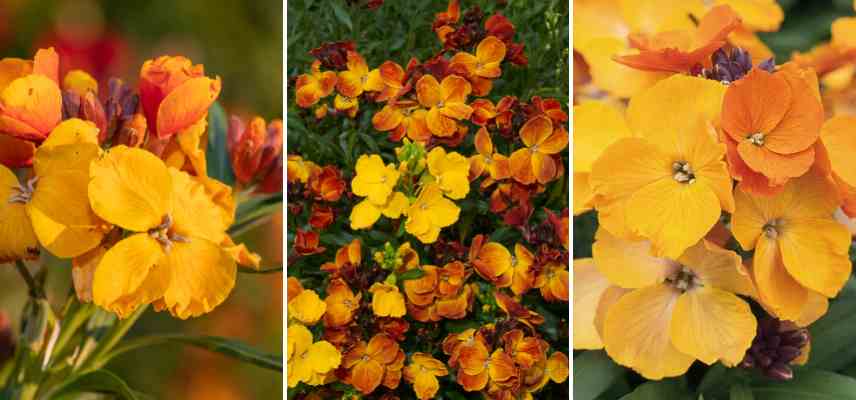
Erysimum cheiri (left and centre) and Erysimum ‘Rysi Copper’
Pink, Mauve and Purple Wallflowers
- The ‘Bowles Mauve’ wallflower is a classic, and the most well-known, with its fine grey-green foliage and mauve flowers.
- ‘Sweet Sorbet’ is a delightful wallflower with salmon-pink tones, almost bicoloured.
- Erysimum linifolium ‘Variegatum’, remarkable for its unique cream-variegated foliage and mauve to purple flowers, can be used in both borders and pots (reaching about 50 cm tall).
- Matthiola longipetala bicornis, highly fragrant with elegant four-petalled mauve flowers.
- Erysimum ‘Poem Lilac’, a true beauty in deep violet tones, also versatile in use (reaching 35 cm tall).
- Matthiola incana ‘Deep Purple’, an annual wallflower with particularly dark, intense purple flowers.
- N.B.: The Virginia stock (Latin name Malcomia maritima) is an annual plant with pastel tones that flowers all summer and self-seeds readily.
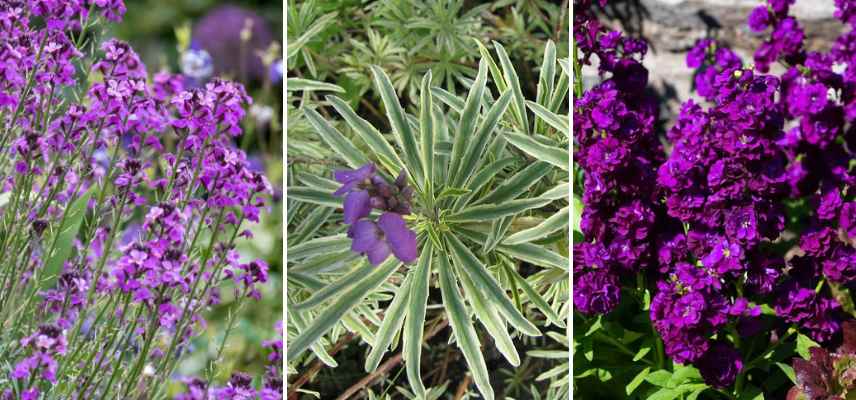
Erysimum ‘Bowles Mauve’, Erysimum linifolium ‘Variegatum’ (©Forest and Kim Starr), Matthiola incana ‘Anytime Deep Purple’
Red to Purple Wallflowers
- ‘Winter Passion’, with deep coppery-red flowers, is a marvel that warms containers from March to June.
- ‘Fire King’, a superb wallflower halfway between red and orange, perfect for “hot borders”.
- ‘Vulcan’ is a classic among red wallflowers, an old variety with purple petals, while ‘Vulcan Brune’ has a more velvety red hue.
- Matthiola incana ‘Anytime Red’, an annual variety with beautiful cherry-red colouring.
- ‘Sugar Rush Red’, with a beautiful scarlet-red hue.
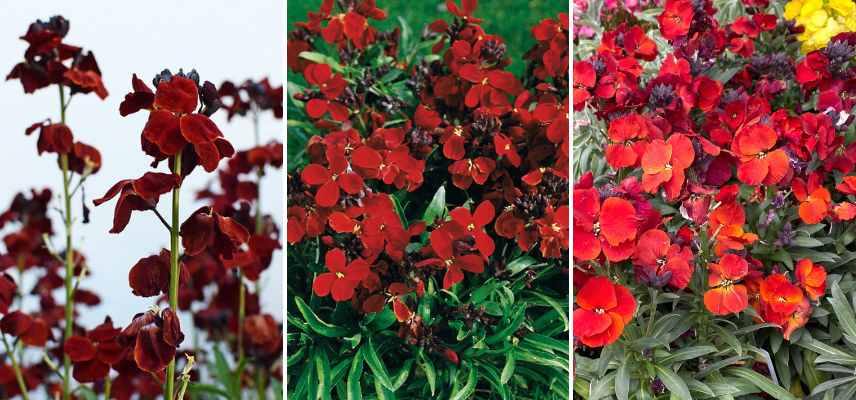
Varieties ‘Vulcan’ (photo: Mark – Flickr), ‘Vulcan Brune’ and ‘Winter Passion’
Bicoloured and Multicoloured Wallflowers
- ‘Constant Cheer’ displays almost every colour, a mix of violet, pink, orange and amber – a true gem that fits everywhere!
- Erysimum ‘John Codrington’, a beautiful variety combining yellow and purple on flower buds.
- ‘Winter Sorbet’ subtly blends orange and mauve, similar to ‘Constant Cheer’.
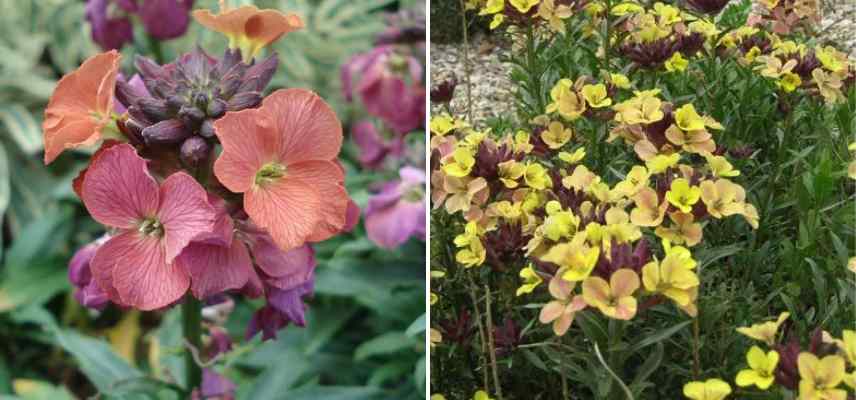
Erysimum ‘Constant Cheer’ and ‘John Codrington’ wallflower
A highly fragrant wallflower: which are the most scented?
The fragrance of wallflowers is one of their most cherished characteristics. This is often why they are so loved in gardens. They are also used in the composition of many well-known perfumes, much like iris or jasmine.
It’s worth noting that their scent intensity depends on growing conditions, varieties, and the time of day they are smelled: wallflowers require full sun exposure to release their sweet fragrance, and their scent intensifies towards the end of the day. Double-flowered varieties are generally more fragrant. While the perennial wallflowers Erysimum cheiri are lightly scented, the annuals Matthiola longipetala, and to a lesser extent Matthiola incana, are the most fragrant.
Here are some varieties to remember for their exquisite scents:
- The wallflower ‘Night Scented Stock’ (Matthiola longipetala bicornis): This annual releases an intense, headed fragrance in the late afternoon and evening, reminiscent of cinnamon and spices, attracting nocturnal pollinators. Its white or pink to mauve flowers are elegant and understated, perfect for romantic gardens.
- The wallflowers from the ‘Cinderella’ series (Matthiola incana): Loved for their sweet fragrance and often double flowers, ranging from white to lavender, as well as their particularly long flowering period.
- The wallflower ‘Winter Orchid’, a multicoloured beauty with a gingerbread-like scent.
- The wallflower ‘Vulcan’ is among the most fragrant of the perennials.
- The wallflower ‘Apricot Twist’, orange, with spicy, sweet, yet distinctly noticeable aromas.
- Erysimum cheiri: The species itself has long been known for its gentle fragrance. The common wallflower or gillyflower even takes its name from the clove. It is ideal for rock gardens or stone walls, where it can thrive in cracks.
- Erysimum cheiri ‘Fragrant Star’: A recent variety, compact and early-flowering, with yellow flowers that develop into bicoloured yellow and purple tones, selected for its stronger fragrance.
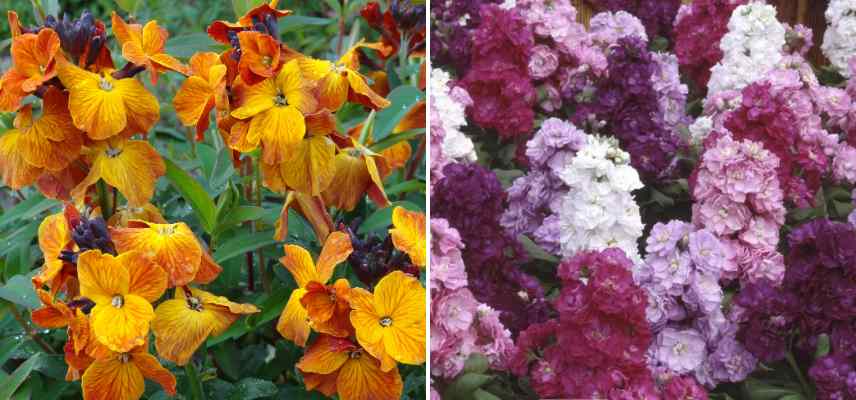
Common wallflower (Erysimum cheiri) and Matthiola incana ‘Cinderella Mix’
A wallflower according to its size and location in the garden
There are dwarf wallflowers that grow close to the ground, and taller, almost shrubby varieties that fill our flower beds in spring or summer. They can therefore be used in very different locations in the garden, depending on their height and spread.
The lowest wallflowers for rockeries, paving and walls
Placed high up on walls, you can enjoy the fragrant scents of wallflowers even more! Also consider dwarf or low-growing wallflowers for gravel gardens.
In natural gardens, choose wild yellow species such as Erysimum amoenum (15 cm tall) or Erysimum capitatum, but you could also opt for Erysimum suffruticosum ‘Gold Cup’, Erysimum alpinum ‘Moonlight’, or the ‘Apricot Twist’ wallflower. As for Erysimum ‘Bowles’, it fits everywhere to add volume.
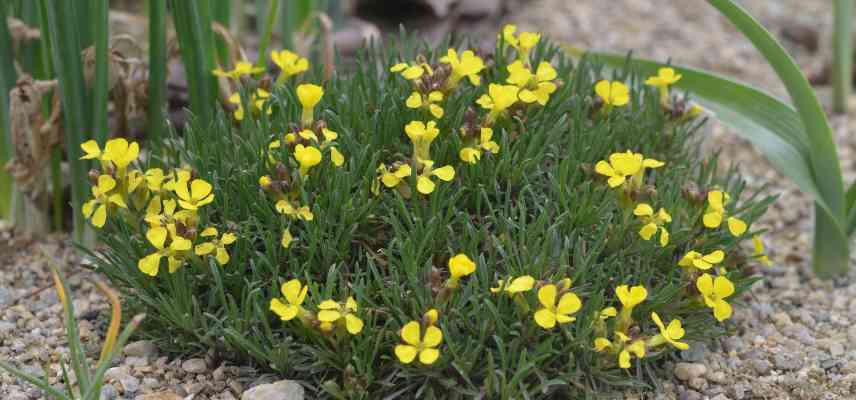
Erysimum kotschyanum
Wallflowers for pots on a balcony or terrace
This is one of their most popular uses! Choose dwarf wallflowers such as ‘Jubilee Gold’, the bicolour ‘Constant Cheer’, or annuals like Matthiola incana mix. Orange wallflowers always create a lovely effect when planted in terracotta pots. The ‘Anytime Yellow’ annual wallflowers with soft pastel yellow hues will tie together any planter.

A beautiful harmony of warm tones between wallflowers and pansies
Wallflowers for flower bed borders
Wallflowers are perfect for creating mixed borders with spring bulbs and perennial geraniums. Some compact wallflowers grow between 20 and 30 cm tall, ideal for walls and rockeries like Erysimum alpinum, but also Erysimum ‘Poem Lilac’, or Erysimum ‘Zwerg Mango’.
Shrubby wallflowers for flower beds
These include the stunning ‘Bowles Mauve’ wallflower, a staple of mixed borders, those grand English-style flower beds. You can also plant Erysimum mutabile (60 cm tall), Matthiola incana (80 cm) for summer flowering, Erysimum cheiri, and many annual and perennial wallflowers, always at home here. The tallest wallflowers also make lovely cut flowers, creating charming country bouquets with lady’s mantle, wood hyacinths and snowball viburnum.
→ Also read Wallflowers: companion planting in the garden or in pots.
A long-flowering or perpetual wallflower
The common wallflower (Erysimum cheiri) boasts the longest flowering period: nearly three months in spring between March and June, bringing an explosion of colour after winter! ‘Winter Joy’, on the other hand, will flower for long months from winter right through to summer.
The latest to bloom are annual wallflowers, which begin flowering around May, whereas perennial wallflowers (Erysimum Cheiri) start flowering as early as February in mild springs, like the aptly named ‘Winter Joy’. They flower for many months, such as Matthiola incana ‘Deep Purple’.
Even earlier, Erysimum suffruticosum brightens borders with its vibrant yellow in winter and again in autumn.
Finally, some wallflowers are more perpetual than others: they flower for a long time in spring, then bloom again in late summer. This is true of Erysimum ‘Bowles Mauve’ or the ‘Sugar Rush’ seriate wallflowers.
Remember that pruning spent flowers encourages wallflowers to produce new blooms. However, you can leave a few to self-seed. One last tip: to extend flowering periods, combine different varieties of wallflowers, mixing annuals and perennials!
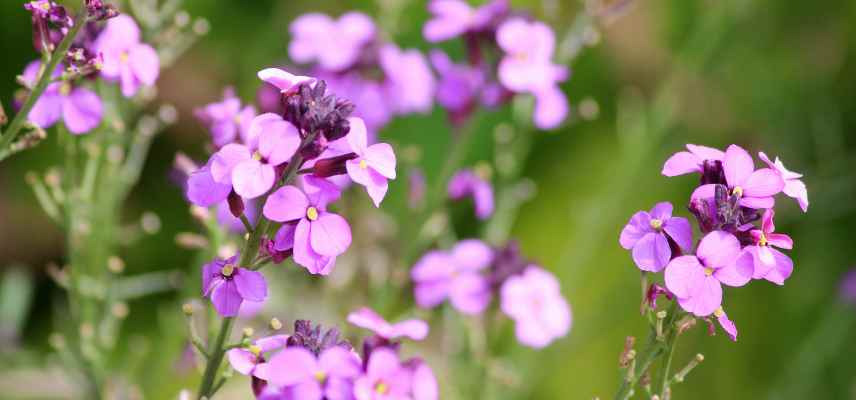
Erysimum ‘Bowles Mauve’
To find out more
Also discover our tutorial: How to sow wallflowers?
- Subscribe!
- Contents































Comments